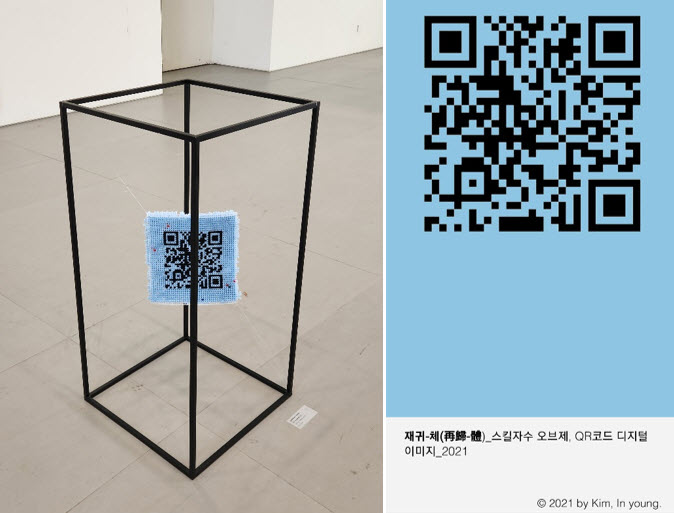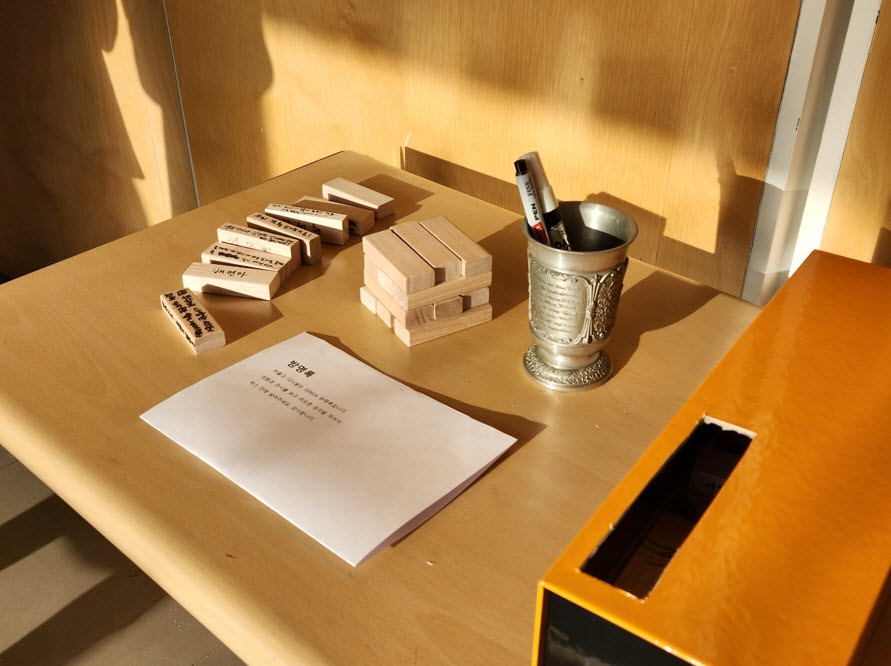At the end of every year, Seoul National University Gwanak Campus is packed with cultural events where students present the results of their hard work. The practice rooms for school clubs, the lounges at the Student Center, the Dure Cultural Center, and the stages in Gwanak Dormitory Gaon Hall are crowded with hip-hop, dance, and band performances. From December 13(Tuesday) to 16(Friday), the exhibition LAYERS: Breaking down and Rebuilding was held in the ground floor of the University Cultural Center. The participants of ‘Art Presentation’, a class opened by the Art Management Program, displayed the results in the event. The exhibition, held together by ideas shared from professors, student artists, and exhibition managers, gave spectators a new perspective of viewing the world.
Different Ideas Torn Down Brick by Brick and Reconstructed
The title LAYERS: Breaking down and Rebuilding conveys the aim to break down established methods of understanding and bring new thoughts when an appreciator meets a piece of art. In-yeong Kim (College of Fine Art, master’s student), Eun-kyeong Lee (College of Fine Art, doctoral student), Han-ul Kim (Department of Painting, master’s student). Kyo-il Yang (Department of Painting, master’s student), Do-yeon Kwon (Department of Design, dortoral student), Yeo-jin Yang (Department of Oriental Painting, master’s student), Hee-won Kim (Department of Painting, master’s student), and Soo-Hyeon Park (Department of Oriental Painting, master’s student) are the eight artists that made pieces from various materials such as canvas, silk, and carpets. Different messages build up to give spectators a new experience of the transition of perspective.

In-yeong Kim’s Recurrent Style(left) and the QR-scanned page
The exhibition starts off with Do-yeon Kwon’s Green Leaf. The glass, candle, leaves, and other plain objects are all scattered and spread across the piece. Images were printed and filled by acrylic coloring. The mix of mechanic work and handwork, and the unrealistic expression of ordinary objects show contrasting layers at the same time, such as digital and analog, reality and virtual reality, and technology and mankind. The thoughtlessly perceived information in the digital world pops up in unexpected ways in real life that brings an unfamiliar experience. In-yeong Kim also worked on digital and analog as a theme. Recurrent Style is a carpet weaved with a QR code on it. Instead of additional information, the QR code itself reappears when one scans the code on their phones It is a work that negates the common perception that QR codes are passages that lead to the digital world. It evokes the thought that digital images can be unattached to the original ones in reality. Han-ul Kim shows the two layers, past and present, in her video Me/Art/My Sister. Her and her sister make a list of words that come to mind when it comes to ‘art’, which is made in the same theme and manner as a video made in 2014. The changes between the 8 years show the course of life that makes today’s ‘me’. At the exit of the exhibition holds a place for visitor’s book, where spectators can write their comments on wooden blocks and stack them up like Jenga. Like the subtitle of the exhibition, it means the spectator’s ideas are added up to make new meanings to the work. “Reading the comments made me see our work in a new way,” said Eun-jeong Lee (Art Management, master’s student) of the planning team.

Stacking the blocks with comments makes a tower shared by spectators, authors, and managers.
An Exhibition Built by Twelve Students All the Way Through
The class ‘Art Presentation’, directed by 23-year exhibition manager professor In-seon Kim, was open on the fall semester of 2021 and is run by the Department of Art Management, a master’s and doctorate program. Students can figure out the situations and systems at work in an exhibition and plan one by themselves through this class. Students are split into the artist team and the management team, and they each exhibit their work and plan for the exhibition. This semester, eight student artists on their master’s and doctorate program for the College of Fine Arts, the Department of Painting, the Department of Design, and the Department of Oriental Painting joined four student managers acquiring their master’s and doctorate degree for Art Management in the class. Artists submit their portfolios, followed by the managers selecting the theme that put the pieces together. After that, exhibit halls are booked, with the promotion and organization on the progress. Participants shared ideas and finished the exhibition. They finished the exhibition all by themselves a day before the event, carrying their work, setting up lamps, painting the walls, and putting up posters in school halls from morning till night. “We had many twists and turns as we didn’t have as much help and money as commercial exhibitions, but we learned a lot through the event”, commented Eun-jeong Lee, who had experienced curation but not the whole process of managing an exhibition. Ye-won Kim (Department of Art Management, master’s student) of the management team saw the preparation as stacking the layers, and received a lot of help from professor Kim when coming up with the main theme of the exhibition. “The chatroom was busy with chats from the professor and students,” she noted, “and this class by far was the most active class with a lot of communication among students.”
Professor Kim stressed that students not only understand the world of art but learn how to communicate, cooperate, and express mutual respect through this class. A group of people having to compromise to finish an exhibition, that is the message of ‘Art Presentation’ and LAYERS.
Student Reporter
Kyu-rim Lee (Department of Journalism)
gyu2129@snu.ac.kr

